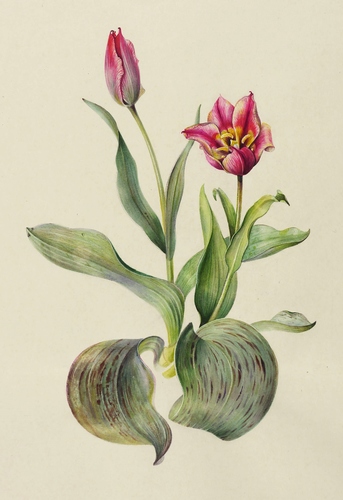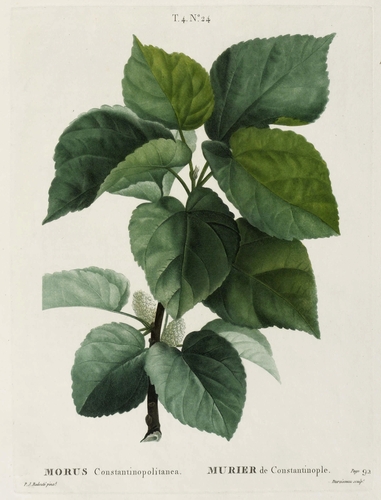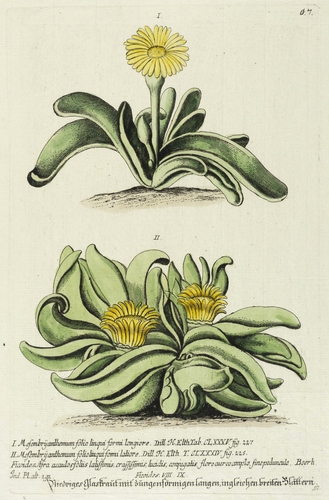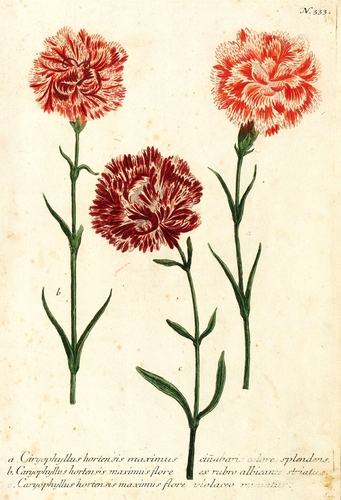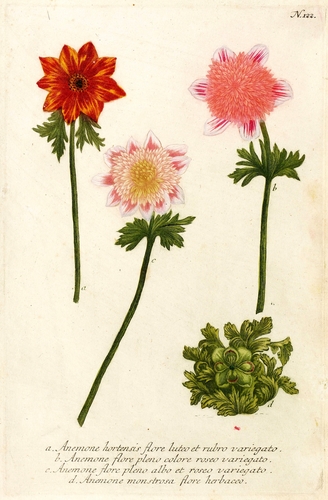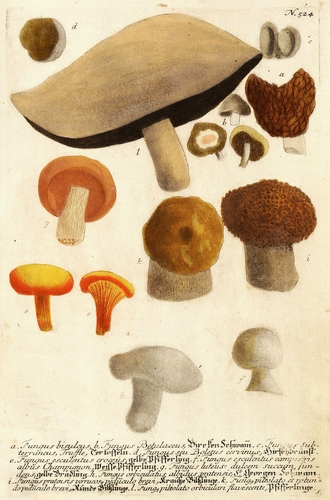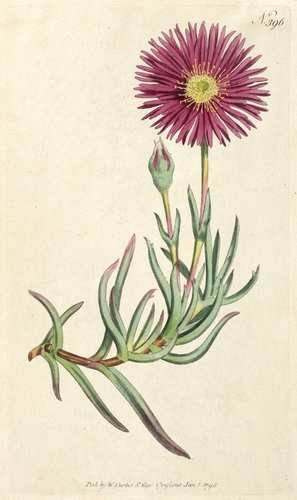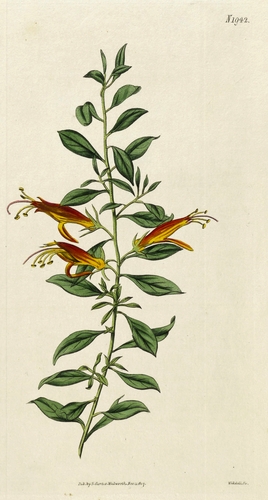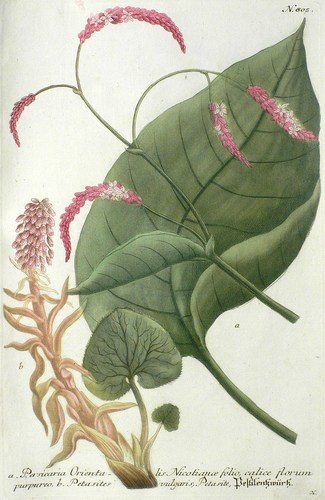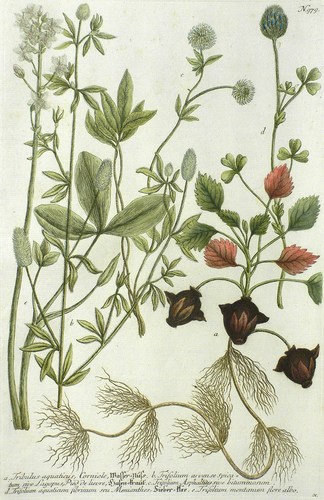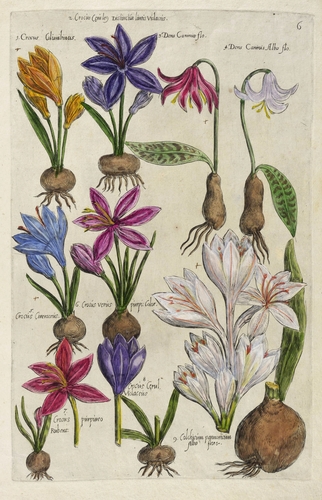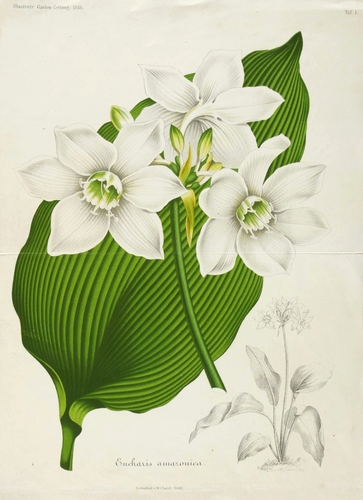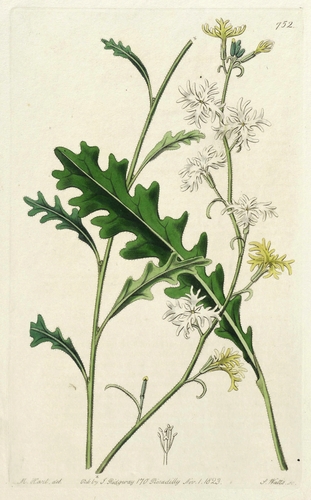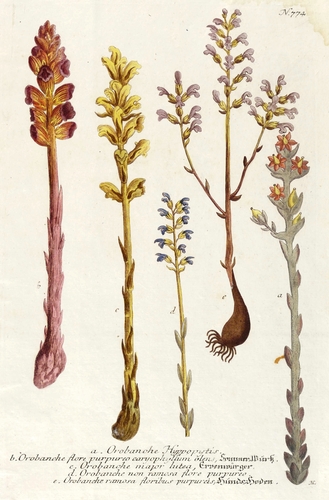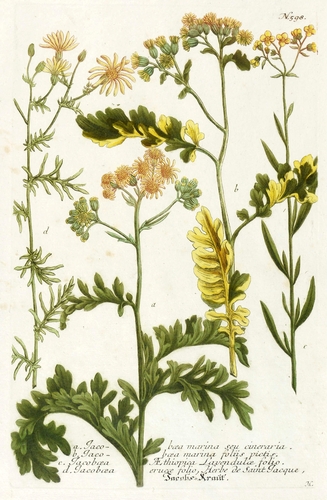
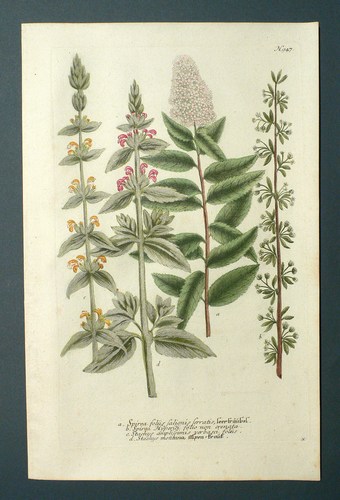
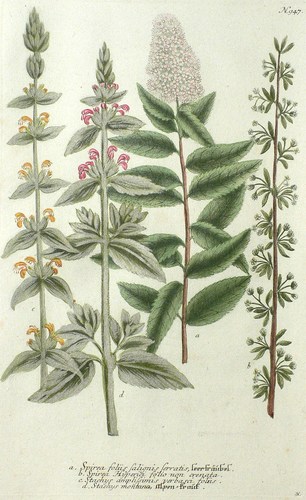
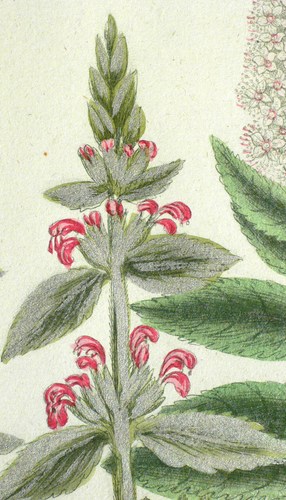
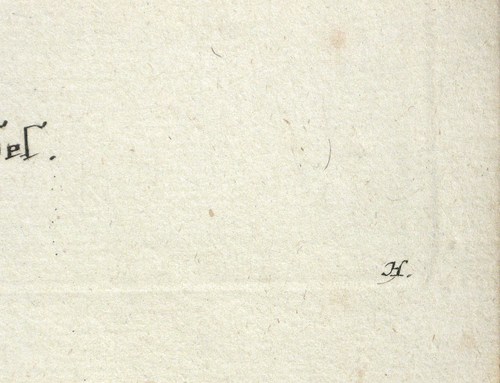
Ziest & Spiersträucher. – Weinmann. – „Leerträubel. Alpen-Kraut”.
1745. Kupferstich / Mezzotinto, alt koloriert. – Historische Pflanzendarstellung, von Johann Jakob Haid. – 33,8 x 21,0 cm (Darstellung / Platte), 39 x 25 cm (Blatt).
6,00 € Germany 14,00 € Europe 32,00 € worldwide
Aus: Johann Wilhelm Weinmann, Phytanthoza-Iconographia Oder Eigentliche Vorstellung Etlicher Tausend, So wohl Einheimisch- als Ausländischer, aus allen vier Welt-Theilen, in Verlauf vieler Jahre (...) gesammelter Pflantzen, Bäume, Stauden, Kräuter, Blumen, Früchten und Schwämme (Regensburg: Lentz 1745), Bd. IV. – Rechts unten Signatur, rechts oben Tafel-Nr. "947", unterhalb mittig ausführliche Inschrift. – Bei der Herstellung der Tafeln arbeiteten die Augsburger Künstler Bartholomäus Seutter, Johann Jakob Haid und Johann Elias Ridinger zusammen. Die Kupfer wurden in einer für die Zeit revolutionären Weise farbig gedruckt und sodann partiell von Hand koloriert. Dabei fand der von Seutter weiterentwickelte Mezzotinto-Farbdruck des Niederländers Johannes Teyler Anwendung. – Das kräftige Büttenpapier sauber und frisch. Wohlerhaltenes Kolorit. Guter Erhaltungszustand.
Johann Jakob Haid (1704 Süßen oder Klein-Eislingen bei Göppingen - 1767 Augsburg). Auch Johann Jacob Hayd. Deutscher Kupferstecher, Schabkünstler, Bildnismaler und Verleger. Vater des Johann Elias Haid (1739-1809). Lernte ab 1726 in Augsburg bei Georg Philipp Rugendas und Johann Elias Ridinger; Schlachten- und Tiermalerei sowie Bildnisse. Später Hinwendung zum Kupferstich und speziell zur Mezzotinto-Technik, der Schabkunst. Gründete in Augsburg ein eigenes Verlagshaus, in dem er erfolgreiche Porträtstichserien in Schabkunst herausgab. Anton Graff und Johann Friedrich Bause zählten zu seinen Schülern.
Augsburger BarockHistorische PflanzendarstellungLippenblütler (Lamiaceae)Rosengewächse (Rosaceae)Heilpflanze / HeilpflanzenZieste (Stachys)Stachys montanaSpiersträucher (Spiraea)
1745. Kupferstich / Mezzotinto, alt koloriert. – Historische Pflanzendarstellung, von Johann Jakob Haid. – 33,8 x 21,0 cm (Darstellung / Platte), 39 x 25 cm (Blatt).
110,00 €
incl. VAT excl. Shipping
incl. VAT excl. Shipping
6,00 € Germany 14,00 € Europe 32,00 € worldwide
Aus: Johann Wilhelm Weinmann, Phytanthoza-Iconographia Oder Eigentliche Vorstellung Etlicher Tausend, So wohl Einheimisch- als Ausländischer, aus allen vier Welt-Theilen, in Verlauf vieler Jahre (...) gesammelter Pflantzen, Bäume, Stauden, Kräuter, Blumen, Früchten und Schwämme (Regensburg: Lentz 1745), Bd. IV. – Rechts unten Signatur, rechts oben Tafel-Nr. "947", unterhalb mittig ausführliche Inschrift. – Bei der Herstellung der Tafeln arbeiteten die Augsburger Künstler Bartholomäus Seutter, Johann Jakob Haid und Johann Elias Ridinger zusammen. Die Kupfer wurden in einer für die Zeit revolutionären Weise farbig gedruckt und sodann partiell von Hand koloriert. Dabei fand der von Seutter weiterentwickelte Mezzotinto-Farbdruck des Niederländers Johannes Teyler Anwendung. – Das kräftige Büttenpapier sauber und frisch. Wohlerhaltenes Kolorit. Guter Erhaltungszustand.
Johann Jakob Haid (1704 Süßen oder Klein-Eislingen bei Göppingen - 1767 Augsburg). Auch Johann Jacob Hayd. Deutscher Kupferstecher, Schabkünstler, Bildnismaler und Verleger. Vater des Johann Elias Haid (1739-1809). Lernte ab 1726 in Augsburg bei Georg Philipp Rugendas und Johann Elias Ridinger; Schlachten- und Tiermalerei sowie Bildnisse. Später Hinwendung zum Kupferstich und speziell zur Mezzotinto-Technik, der Schabkunst. Gründete in Augsburg ein eigenes Verlagshaus, in dem er erfolgreiche Porträtstichserien in Schabkunst herausgab. Anton Graff und Johann Friedrich Bause zählten zu seinen Schülern.
Augsburger BarockHistorische PflanzendarstellungLippenblütler (Lamiaceae)Rosengewächse (Rosaceae)Heilpflanze / HeilpflanzenZieste (Stachys)Stachys montanaSpiersträucher (Spiraea)
You might also like the following works:
Zierpflanzen. – Tulpen. - Greig-Tulpe. – Felsko-Schülke. – „Tulipa Greigii”.
1967. Aquarell, auf glattem hellgelbem Velinkarton. – Von Elsa Maria Felsko-Schülke. – 24,4 x 16,6 cm (Darstellung), 40 x 30 cm (Blatt),
1967. Aquarell, auf glattem hellgelbem Velinkarton. – Von Elsa Maria Felsko-Schülke. – 24,4 x 16,6 cm (Darstellung), 40 x 30 cm (Blatt),
240,00 €
Gehölze. – Maulbeerbaum. - Weiße Maulbeere. – nach Pierre-Joseph Redouté „Morus Constantinopolitanea. Murier de Constantinople”.
1801-1819. Farbkupferstich / Punktstich, auf feinem Velin. – Originalgrafische Buchillustration, von Duruisseau, L.F., nach Pierre-Joseph Redouté. – 30,1 x 22,5 cm (Darstellung / Platte), 39,5 x 28 cm (Blatt),
1801-1819. Farbkupferstich / Punktstich, auf feinem Velin. – Originalgrafische Buchillustration, von Duruisseau, L.F., nach Pierre-Joseph Redouté. – 30,1 x 22,5 cm (Darstellung / Platte), 39,5 x 28 cm (Blatt),
240,00 €
Mittagsblumengewächse. – Mesembryanthemum. – „I. Mesembryanthemum folio linqui [...] Niedriges Glaskraut mit zungenförmigern langen, ingleichen breiten Blättern”.
Um 1760. Kupferstich / Linienstich, alt koloriert. – Historische Pflanzendarstellung. – 30,9 x 19,6 cm (Darstellung / Platte), 43,5 x 27,5 cm (Blatt),
Um 1760. Kupferstich / Linienstich, alt koloriert. – Historische Pflanzendarstellung. – 30,9 x 19,6 cm (Darstellung / Platte), 43,5 x 27,5 cm (Blatt),
120,00 €
Nelken. – Gartennelke. – Weinmann. – „Caryophyllus hortensis”.
1739. Kupferstich / Mezzotinto, alt koloriert. – Historische Pflanzendarstellung, von Bartholomäus Seutter. – 32,0 x 21,8 cm (Darstellung / Platte), 36 x 23 cm (Blatt),
1739. Kupferstich / Mezzotinto, alt koloriert. – Historische Pflanzendarstellung, von Bartholomäus Seutter. – 32,0 x 21,8 cm (Darstellung / Platte), 36 x 23 cm (Blatt),
280,00 €
Weidenröschen (Anemonen). – Stern-Anemone & Buschwindröschen. – Weinmann. – „Anemone hortensis. Anemone monstrosa”.
1737. Kupferstich / Mezzotinto, alt koloriert. – 32,4 x 21,1 cm (Darstellung / Platte), 35,5 x 22,5 cm (Blatt),
1737. Kupferstich / Mezzotinto, alt koloriert. – 32,4 x 21,1 cm (Darstellung / Platte), 35,5 x 22,5 cm (Blatt),
190,00 €
Pilze. – Pfifferlinge, Morcheln & Trüffel. – Weinmann. – „Bircken Schwam[m]. Tertoffeln. Hirschbrunst. Gelbe Pfifferling. Weisse Pfifferling. Gelbe Prädling. St. Georgen Schwam. Biltzlinge. Pfifferlinge”.
1739. Kupferstich / Mezzotinto, alt koloriert. – Historische Pflanzendarstellung, von Bartholomäus Seutter. – 32,0 x 20,7 cm (Darstellung / Platte), 35 x 22,5 cm (Blatt),
1739. Kupferstich / Mezzotinto, alt koloriert. – Historische Pflanzendarstellung, von Bartholomäus Seutter. – 32,0 x 20,7 cm (Darstellung / Platte), 35 x 22,5 cm (Blatt),
280,00 €
Ingwergewächse. – Ingwer. – Blackwell. – „Zerumbet”.
1765. Kupferstich, alt koloriert. – Historische Pflanzendarstellung, von Nicolaus Friedrich Eisenberger. – 30,6 x 19,8 cm (Darstellung / Platte), 38 x 24 cm (Blatt),
1765. Kupferstich, alt koloriert. – Historische Pflanzendarstellung, von Nicolaus Friedrich Eisenberger. – 30,6 x 19,8 cm (Darstellung / Platte), 38 x 24 cm (Blatt),
190,00 €
Mittagsblumengewächse. – Mesembryanthemum spectabile. – Curtis..
1798. Radierung / Kupferstich, alt koloriert. – Historische Pflanzendarstellung, von John Curtis. – 20,4 x 11,8 cm (Darstellung / Platte), 23 x 13,5 cm (Blatt),
1798. Radierung / Kupferstich, alt koloriert. – Historische Pflanzendarstellung, von John Curtis. – 20,4 x 11,8 cm (Darstellung / Platte), 23 x 13,5 cm (Blatt),
40,00 €
Braunwurzgewächse. – Emusträucher. - Eremophila glabra. – Curtis..
1817. Radierung / Kupferstich, alt koloriert. – Historische Pflanzendarstellung, von E. Weddell. – 16,9 x 8,7 cm (Darstellung), 23 x 13,5 cm (Blatt),
1817. Radierung / Kupferstich, alt koloriert. – Historische Pflanzendarstellung, von E. Weddell. – 16,9 x 8,7 cm (Darstellung), 23 x 13,5 cm (Blatt),
30,00 €
Wildkräuter. – Orientalischer Knöterich & Pestwurz. – Weinmann. – „Pestilentzwurtz”.
1742. Kupferstich / Mezzotinto, alt koloriert. – Historische Pflanzendarstellung, von Johann Jakob Haid. – 33,4 x 21,4 cm (Darstellung / Platte), 38,5 x 25 cm (Blatt),
1742. Kupferstich / Mezzotinto, alt koloriert. – Historische Pflanzendarstellung, von Johann Jakob Haid. – 33,4 x 21,4 cm (Darstellung / Platte), 38,5 x 25 cm (Blatt),
120,00 €
Wildkräuter. – Wassernuss, Hasen-Klee & Fieberklee. – Weinmann. – „Wasser-Nuss. Hasenkraut. Fieber-Klee”.
1745. Kupferstich / Mezzotinto, alt koloriert. – Historische Pflanzendarstellung, von Johann Jakob Haid. – 33,3 x 21,4 cm (Darstellung / Platte), 39 x 24,5 cm (Blatt),
1745. Kupferstich / Mezzotinto, alt koloriert. – Historische Pflanzendarstellung, von Johann Jakob Haid. – 33,3 x 21,4 cm (Darstellung / Platte), 39 x 24,5 cm (Blatt),
110,00 €
Krokus, Herbstzeitlose & Zahnlilie..
Um 1740. Kupferstich / Radierung, alt koloriert. – 33,0 x 21,1 cm (Darstellung / Platte), 39 x 26 cm (Blatt),
Um 1740. Kupferstich / Radierung, alt koloriert. – 33,0 x 21,1 cm (Darstellung / Platte), 39 x 26 cm (Blatt),
210,00 €
Amaryllisgewächse. – Amazonaslilie / Herzenskelch (Eucharis amazonica). – Illustrirte Gartenzeitung. – „Eucharis amazonica”.
1858. Lithografie / Chromolithografie. – Historische Pflanzendarstellung. – 29,6 x 21,5 cm (Darstellung), 34,5 x 25,5 cm (Blatt),
1858. Lithografie / Chromolithografie. – Historische Pflanzendarstellung. – 29,6 x 21,5 cm (Darstellung), 34,5 x 25,5 cm (Blatt),
40,00 €
Kreuzblütler. – Schizopetalon walkeri. – Curtis..
1823. Radierung / Kupferstich, alt koloriert. – Historische Pflanzendarstellung, von J. Watts. – 20,3 x 12,3 cm (Darstellung / Platte), 24 x 15 cm (Blatt),
1823. Radierung / Kupferstich, alt koloriert. – Historische Pflanzendarstellung, von J. Watts. – 20,3 x 12,3 cm (Darstellung / Platte), 24 x 15 cm (Blatt),
35,00 €
Sommerwurzgewächse. – Sommerwurzen. – Weinmann. – „Sommer-Wurtz. Ervenwürger. Hunds-Hoden”.
1742. Kupferstich / Mezzotinto, alt koloriert. – Historische Pflanzendarstellung, von Johann Jakob Haid. – 33,0 x 21,3 cm (Darstellung / Platte), 38,5 x 24,5 cm (Blatt),
1742. Kupferstich / Mezzotinto, alt koloriert. – Historische Pflanzendarstellung, von Johann Jakob Haid. – 33,0 x 21,3 cm (Darstellung / Platte), 38,5 x 24,5 cm (Blatt),
150,00 €











